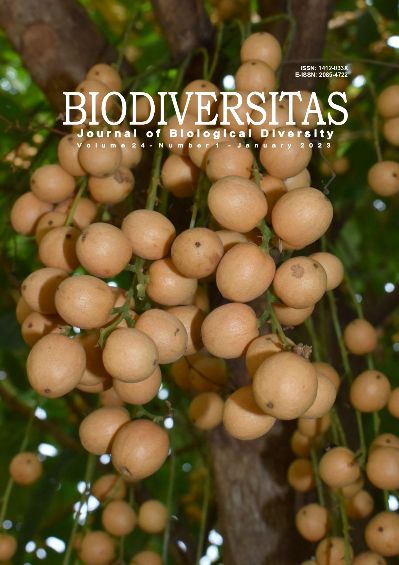The morphoanatomy, histochemistry, and phytochemistry of the leaves and fruits of Rhodomyrtus tomentosa
##plugins.themes.bootstrap3.article.main##
Abstract
Abstract. Kuntorini EM, Sari SG, Fariani R. 2023. The morphoanatomy, histochemistry, and phytochemistry of the leaves and fruits of Rhodomyrtus tomentosa. Biodiversitas 24: 98-105. Rhodomyrtus tomentosa (Ait.) Hassk is native to Southeast Asia. The entire plant has been used in traditional Vietnamese, Chinese, and Malaysian medicine for a long time. Bioactive substances are abundant in ripe fruits. However, few studies have examined phytochemical changes and distribution throughout leaf and fruit growth. This study evaluated the morphoanatomy, histochemical, and phytochemical properties of R. tomentosa leaves and fruits. The cross-sectional anatomical structures observed in the leaves included the epidermis, mesophyll, and carrier bundle, while the fruit structures observed included a pericarp layer with an exocarp/outer layer, mesocarp, and endocarp. Flavonoids, tannins, terpenoids, and alkaloids were found in the leaf's adaxial and abaxial epidermis, mesophyll, xylem, phloem, midrib parenchyma, secretory cavities, and trichomes. They were also distributed throughout the fruit's exocarp, mesocarp, endocarp, secretory cavities, xylem, phloem, trichomes, and seeds. Young leaves contained the highest total flavonoid concentration (196 ± 1.77 mg QE/g), green fruit had the highest total phenol concentration (97.70 ± 18.15 mg GAE/g), old leaves contained the highest total alkaloid concentration (13.22 ± 0.98%), and red fruit had the highest total tannin concentration (1.66 ± 0.15 mg GAE/g).
##plugins.themes.bootstrap3.article.details##
Most read articles by the same author(s)
- EVI MINTOWATI KUNTORINI, LAURENTIUS HARTANTO NUGROHO, Structural development and bioactive content of red bulb plant (Eleutherine americana); a traditional medicines for local Kalimantan people , Biodiversitas Journal of Biological Diversity: Vol. 11 No. 2 (2010)
- EVI MINTOWATI KUNTORINI, MARIA DEWI, MISRINA MISRINA, Anatomical structure and antioxidant activity of red bulb plant , Biodiversitas Journal of Biological Diversity: Vol. 17 No. 1 (2016)
- EVI MINTOWATI KUNTORINI, LILING TRIYASMONO, MARIA DEWI ASTUTI, Antioxidant activity and 1H NMR profiling of leaves and fruits of Rhodomyrtus tomentosa from South Kalimantan, Indonesia , Biodiversitas Journal of Biological Diversity: Vol. 25 No. 5 (2024)

